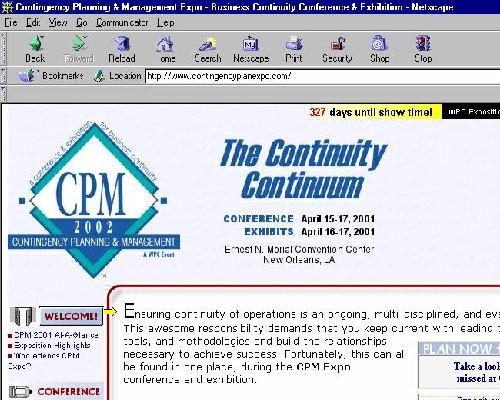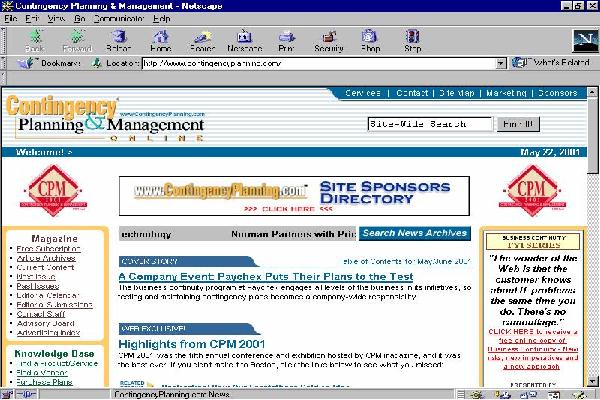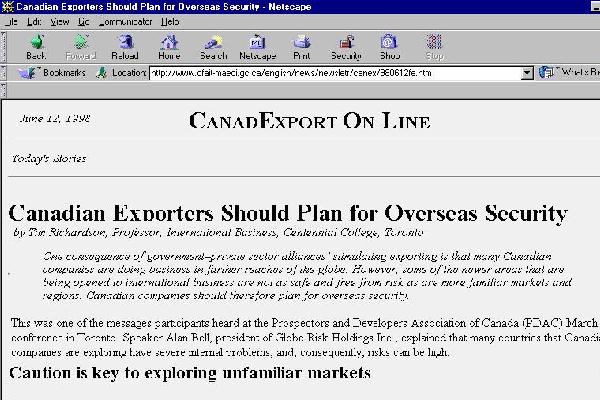 |
BUS 203
Business & Human Resources |
|
|
||
|
||
|
|
|
Strategy
Strategy
Strategy
Strategy |
Rob Spiegel wrote story
in the Jan 26th E-Commerce Times titled
"Report: 70 Percent of Retailers Lack E-Commerce Strategy" Rob's story was based on
a new study by Deloitte and Touche that shows that while roughly one third
of retailers with a Web presence consider their online store to be
"strategic," a majority have set up Web operations with no clearly
articulated strategy and are merely "testing the waters to gauge
Internet demand."
Components of a good strategy
http://www.sob.cencol.on.ca/faculty/trichard/GNED119/Chpt8/sld010.htm see also http://www.occc.com/marketing/m-4.htm the following explanations on GOPST comes partly from www.occc.com/marketing/m-4.htm and partly from WTGR Goals--
Goals are the ultimate thing you want to achieve. They are the statements
that a company uses to motivate employees and statements used to judge
and measure challenges that you face. Excellently worded goals should include
measurable statements.
Examples:
. Examples:
(theoretically if you have the largest product offering, you have the potential to make the largest sales, which helps fulfill the goal) Plans can include such concepts as
Examples:
SWOT is an acronym that stands for
Examples:
|
| Class
1 |
Discussed in class, the
purpose and usefulness of understanding
|
| In the 1st class, after
we discussed GOPST, we did a practical exercise in class that involved
the students working in groups to create a scenario for which a GOPST would
be needed, and then write out on paper the various details.
Class participation marks were awarded for this activity. |
| Famous
Asian Planners and Strategists Historical
|
|
| Famous
European Planners and Strategists Historical
|
|
| Time
Management The
Time
|
"To be an effective manager
you must be a good time manager."
|
| In 1965 the average CEO made 44 times the average factory worker. Today, the average CEO makes 212 times the salary of the average worker. |
| . | Contingency
Planning is not "Good" planning. It is planning for when things go bad.
In order to be adept at contingency planning, you have to have as much information as possible about the weakness of your organization and resources, then imagine all the bad things that could happen which would effect you negatively. Contingency planning can
be considered "Good", when the plans you create are successful in dealing
with any of the bad situations that arise, and prevent harm to your human
resources, and prevent loss to your property, inventory, and resources.
|
| contingency
planning & business continuity solutions |
Contingency
Planning has become such an important part of business planning in the
1990's and Millenium, that it has become a complete area of study. New
terms have also been developed such as "business continuity" - which
is just a fancy way of saying
"keeping your business going even though really bad stuff happened to the company" It is possible to find many web sites with information about contingency planning & business continuity solutions. There are
|
| contingency
planning & business continuity solutions |

This conference, put on in April 2001, begins by saying "... continuity of operations is an ongoing, multi-disciplined, and ever-changing task" |
| web
sites contingency
web
|
 |
| In the 3rd class, after
we discussed contingency planning, we did a practical exercise in class
that involved the students working in groups to create a scenario for which
a Contingency Plan was needed, and then write out on paper the various
details of the plan.
The exercise is at http://www.witiger.com/senecacollege/BUS203/exercise2.htm Class participation marks were awarded for this activity. |
|
Government Resources contingency
Government
Government
contingency
Government
Government
contingency
Government
|
Contingency Planning is also used extensively in International Business 
The screen capture above
is from the web site of CanadExport of the Dept. of Foreign Affairs.
In this article, Prof. Richardson says "One consequence of government–private sector alliances’ stimulating exporting is that many Canadian companies are doing business in farther reaches of the globe. However, some of the newer areas that are being opened to international business are not as safe and free from risk as are more familiar markets and regions. Canadian companies should therefore plan for overseas security." "...these newer areas can be rewarding for exporters, but Canadian companies need to exercise caution. ...Contingency plan one way to address risks" Contingency plans can cover such situations as:
|
||
| Security
Services Companies contingency
Security
Security
contingency
Security
|
Globe Risk, "There are many questions when it comes to contingency planning and crisis management. Similar to an insurance policy, it prepares your company for any disasters it may encounter. Even more like an insurance policy, it can either be money wasted or well spent. When a crisis strikes your firm, it will be too late to find out. Then it will be up to legal teams representing damaged parties, injured employees and government regulators to determine your liabilities. " |
Class 4

Chapter 6 Class 4
|
Once you understand what
it takes to make good plans, to achieve the objectives, to satisfy the
goals, it is necessary to have an understanding of some of the barriers
which would stop you carrying out the plans effectively.
text page 176-177 Guidelines for making Objective Setting and Planning effectively
|
| MBO
Class 4
MBO
|
MBO Management By Objectives
You can find web sites which
are devoted to complete courses that just focus on MBO, such as
|
| MBO
is a process |
MBO - is a Process
http://www.vidyapatha.com/pd05.htm MBO is a collaborative process
whereby the Leader and team members can jointly determine objectives for
each team members. MBO begins when the Team Leader explains the goals for
his group. The team members take the goals and propose objective for his
/ her particular job. In case of any modification of individual’s objectives,
it is accomplished through negotiation since the Team Leader has resources
to help the team member commit to the achievement of the objective. Thus,
a set of verifiable objectives for each team member are jointly determined,
prioritized and formalised.
|
| MBO
Class 4
MBO
MBO Class 4
MBO
MBO Class 4
MBO
|
Generally, an MBO system includes the following components. (this is not from the text, this is from a web site) 1. Development of role &
mission statement.
from Robert Bacal http://members.nbci.com/_XMCM/cooperate/pmch1.htm another example of a list
of MBO principles can be found at
What Is Performance Management Supposed To Accomplish? Robert Bacal says "The literature
regarding MBO and performance management suggests a plethora of benefits
and purposes that are designed to make organizations more effective. We
can summarize them as follows:
1. Increases management control
over work and results.
Some people, like Robert Bacal says that "while performance management can be described as absolutely logical, the assumptions underlying it that relate to organization effectiveness are somewhat flawed... traditional performance management contains many excellent notions, but that the positive things about it are lost in a morass of conflicting purposes that usually guarantee that it will not work." Downside to Performance Management? Robert Bacal says " Is it possible that traditional performance management programs cause problems for an organization? The answer is a resounding yes. The performance management system conveys to people in an organization how work is to be performed, and communicates, often unintentionally, values and organizational culture. More specifically traditional performance management systems can foster a lack of collective responsibility for the achievement of organizational goals, encourage competition rather than cooperation, and can impede the development of effective teamwork." |
| MBO
and "Objectives" MBO
|
MBO - the "Objectives"
part.
"Most supervisors set objectives,
but not with equal skill. Few, who do not correctly write objectives, will
reap MBO's full benefits. An objective is simply a statement of what is
to done and should be stated in terms of [measurable] results."
Professor Gemmy Allen'smnemonic aid to write objectives is SMART
An objective must be specific with a single key result. If more than one result is to be accomplished, more than one objective should be written.Measurable An objective must be measurable. Only an objective that affects behavior in a measurable way can be optimally effective. If possible, state the objective as a quantity - example, the number one company, by passenger car sales, in Toronto.Attainable An objective must be attainable with the resources that are available. It must be realistic. Many objectives are realistic. Yet, the time it takes to achieve them may be unrealistic. It would not be realistic for a truck dealership to switch to cars, and then say its objective is to be the number one seller of cars because competition would be too tough in the short run.Result-oriented The objective should be central to the goal of the organization. The successful completion of the objective should make a difference - If it is not, then the statement is not important enough to be an objective.Time-limited The objective should be something that can be achieved in a resonable period of time, so that the goal can be met, without problems. Specific objectives enable time priorities to be set and time to be used on objectives that really matter. Are the time lines you have established realistic? Will other competing demands cause delay?
|
MBO

International |
MBO - International
|